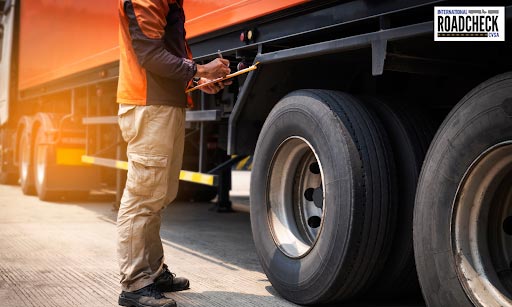What carriers and shippers need to know about this annual 72-hour inspection event.

With May quickly approaching, now is the time for truck drivers and carriers to prepare for one of the year’s most important events. International Roadcheck, which is headed by the Commercial Vehicle Safety Alliance (CVSA), is scheduled to take place May 17-19th. At LYNC Logistics, we want to help prepare drivers, carriers and shippers for what to expect so that an inspection doesn’t halt a shipment.
The Basics: What is International Roadcheck?
We know everyone “loves” inspections. However, they are necessary because they help keep our roads safe and potentially prevent catastrophic events from happening due to faulty equipment, etc. International Roadcheck takes place over a 72 hour period. During that time, commercial motor vehicles and drivers in the United States, Mexico, and Canada, will undergo a 37-step North American Standard Inspection. These inspections, which are categorized as Level I, will take place at various sites like weigh stations. Passing vehicles will receive a CVSA decal which typically means they will not be inspected again within the following three months. Keep in mind that inspectors may perform other levels of inspections like a Level II Walk-Around Driver/Vehicle Inspection or Level III Driver/Credential/Administrative Inspection, but only vehicles that pass a Level I or V (Vehicle-Only Inspection) can receive a CVSA decal.
The Focus: Wheel Ends
Each year the CVSA picks a different focus area. Last year, all eyes were on lighting and hours of service. For 2022, inspectors will be moving their focus to wheel ends. Close to 25% of inspection violations have to do with, you guessed it, wheel end components. For data lovers, wheel ends typically find themselves ranked on the “Top 10 Vehicle Violations” list. Wheel end components are extremely important because they help drivers maintain stability and control of a commercial vehicle, support heavy loads, and help with breaking. Wheel end components are covered in steps 15 and 18 of the 37-step inspection. Some of the things inspectors will look for include leaks in tires and valve stems, debris between tires, damaged wheel fasteners, and tread wear. Of course, inspectors will look at much more than just wheel ends. The CVSA has put together a cheat sheet for carriers and drivers to use to prepare for every aspect of the inspection. You can view it by clicking here.
The Results: Four Possible Outcomes
If you’ve ever tuned into any reality singing competition, then you know that the results are the most anticipated, nerve-wracking part of the whole process. At least you can count on your inspector to not channel Ryan Seacrest and say “dim the lights, here we go.” However, we think it would be cool if they threw confetti or something when you pass. Unfortunately, though, not every driver or vehicle will pass. During 2021’s International Roadcheck, 40,000 commercial vehicle inspections were conducted. The great news is that the CVSA said that over 80% of vehicles examined passed and did not have any out-of-service (OOS) violations. However, over 6,700 vehicles and more than 2,000 drivers did have violations that took them off the road until they were addressed. How exactly are vehicles graded? Let’s break it down.
- The Passing Group – This group has ZERO violations and receives their CVSA decal. (insert confetti here)
- The Phew Group – This group has some violations, but they are not ones categorized as “critical.” While breathing a huge sigh of relief, this group can continue driving and will also receive a coveted CVSA decal. However, if those non-critical violations have anything to do with a rear impact guard, then a decal will not be issued.
- The Critical… But Still Kicking Group – This group has critical violations, but those violations do not translate into OOS violations. These vehicles are approved to get back on the road, but they will not receive a CVSA decal.
- The Weakest Link Group – Unfortunately, this group has OOS violations, which are identified based on the North American Standard Out-Of-Service Criteria, and will have to address identified violations before being given a thumbs up to return to the road.
Even if a vehicle passes and is permitted to return to the road, a driver can lose his or her right to drive. When it comes to drivers, inspectors look at operating credentials, impairment due to drugs or alcohol, hours-of-service documentation, and seat belt usage.
All drivers and carriers need to keep in mind that even if they are permitted to continue operating, any violations can impact the carrier’s Compliance, Safety, Accountability (CSA) score. Due to this, carriers need to address all violations immediately to prevent further issues that can result if violations are found during future inspections.
The Key: Be Prepared
For carriers and drivers, the International Roadcheck can be nerve-wracking and pressure-filled. While for shippers, it can cause great anxiety and concerns that shipments will be delayed. The key to passing with flying colors is to prepare. Carriers should make sure all drivers are routinely performing pre and post-trip inspections to ensure everything is in working order. They should also take time to review their company’s data using the U.S. Department of Transportation’s Federal Motor Carrier Safety Administration’s Safety and Fitness Electronic Records (SAFER) System on a monthly basis. If any of a carrier’s vehicles undergo repairs to address violations, then documentation needs to be kept on file. Prior to International Roadcheck, make sure all vehicles are clean both inside and out. Also, we recommend that carriers perform mock inspections to ensure both vehicles and drivers are ready.
No Brokers. Just Fixers.
Our LYNC team knows how important delivering a shipment on time is to both carriers and shippers. If a shipment is delayed due to a failed inspection, our team is here to help get the shipment to its intended destination in a timely manner. We will stay with both the carrier and shipper throughout the entire process to ensure everything is taken care of